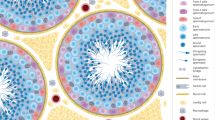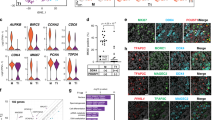Abstract
Azoospermia or oligozoospermia due to disruption of spermatogenesis are common causes of human male infertility. We used the technique of spermatogonial transplantation in two infertile mouse strains, Steel (Sl) and dominant white spotting (W), to determine if stem cells from an infertile male were capable of generating spermatogenesis. Transplantation of germ cells from infertile Sl/Sld mutant male mice to infertile W/Wv or Wv/W54 mutant male mice restored fertility to the recipient mice. Thus, transplantation of spermatogonial stem cells from an infertile donor to a permissive testicular environment can restore fertility and result in progeny with the genetic makeup of the infertile donor male.
This is a preview of subscription content, access via your institution
Access options
Subscribe to this journal
Receive 12 print issues and online access
$209.00 per year
only $17.42 per issue
Buy this article
- Purchase on Springer Link
- Instant access to full article PDF
Prices may be subject to local taxes which are calculated during checkout



Similar content being viewed by others
References
Greenberg, S.H., Lipshultz, L.I. & Wein, A.J. Experience with 425 subfertile male patients. J. Urol. 119, 507–510 ( 1978).
Sigman, M., Lipshulz, L.I. & Howard, S.S. in Infertility in the Male 3rd ed. (eds. Lipshulz, L.I. & Howard, S.S.) 173–193 (Mosby, St. Louis, 1997).
Russell, L.D., Ettlin, R.A., SinhaHikim, A.P. & Clegg, E.D. in Histological and Histopathological Evaluation of the Testis 1–40 (Cache River, Clearwater, Florida 1990).
Silvers, W.K. in The Coat Colors of Mice 206–223 (Springer Verlag, New York, 1979).
Brinster, R.L. & Zimmermann, J.W. Spermatogenesis following male germ-cell transplantation. Proc. Natl. Acad. Sci. USA 91, 11298–11302 (1994).
Brinster, R.L. & Avarbock, M.R. Germline transmission of donor haplotype following spermatogonial transplantation. Proc. Natl. Acad. Sci. USA 91, 11303–11307 (1994).
Ogawa, T., Aréchaga, J.M., Avarbock, M.R. & Brinster, R.L. Transplantation of testis germinal cells into mouse seminiferous tubules. Int. J. Dev. Biol. 41, 111–122 (1997).
Chabot, B., Stephenson, D.A., Chapman, V.M., Besmer, P. & Bernstein, A. The proto-oncogene c-kit encoding a transmembrane tyrosine kinase receptor maps to the mouse W locus. Nature 335, 88–89 (1988).
Geissler, E.N., Ryan, M.A. & Housman, D.E. The dominat white spotting (W) locus of the mouse encodes the c-kit proto-oncogene. Cell 55, 185–192 (1988).
Zsebo, K.M. et al. Stem cell factor is encoded at the Sl locus of the mouse and is the ligand for the c-kit tyrosine kinase receptor. Cell 63, 213–224 ( 1990).
Huang, E. et al. The hematopoietic growth factor KL is encoded by the Sl locus and is the ligand of the c-kit receptor, the gene product of the W locus. Cell 63, 225–233, 1990.
Nocka, K. et al. Expression of c-kit gene products in known cellular targets of W mutations in normal and W mutant mice – evidence for impaired c-kit kinase in mutant mice. Genes Dev. 3, 816–826 (1989).
Ogawa, M. et al. Expression and function of c-kit in hemopoietic progenitor cells. J. Exp. Med. 174, 63– 71 (1991).
Sorrentino, V., Giorgi, M., Geremia, R., Besmer, P. & Rossi, P. Expression of the c-kit proto-oncogene in the murine male germ cells. Oncogene 6, 149– 151 (1991).
Matsui, Y., Zsebo, K.M. & Hogan, B.L.M. Embryonic expression of a haematopoietic growth factor encoded by the Sl locus and the ligand for c-kit. Nature 347, 667–669 ( 1990).
Russell, E.S. Hereditary anemias of the mouse: A review for geneticists. Adv. Genet. 20, 357–459 ( 1979).
Russell, E.S., Bernstein, S.E., Lawson, F.A. & Smith, L.J. Long-continued function of normal blood-forming tissue transplanted into genetically anemic hosts. J. Natl. Cancer Inst. 23, 557–566 (1959).
McCulloch, E.A., Siminovich, E.A. & Till, J.L. Spleen-colony formation in anemic mice of genotype W/Wv. Science 144, 844–846 (1964).
Bernstein, S.E. Tissue transplantation as an analytic and therapeutic tool in hereditary anemias . Am. J. Surg. 119, 448– 451 (1970).
Mayer, T.C. & Green, M.C. An experimental analysis of the pigment defect caused by mutations at the W and Sl loci in mice. Dev. Biol. 18, 62–75 ( 1968).
Huszar, D., Sharpe, A. & Jaenisch, R. Migration and proliferation of cultured neural crest cells in W mutant neural crest chimeras. Development 112, 131–141 (1991).
Manova, K. et al. The expression pattern of the c-kit ligand in gonads of mice supports a role for the c-kit receptor in oocyte growth and in proliferation of spermatogonia. Dev. Biol. 157, 85– 99 (1993).
Dolci, S. et al. Primordial germ cell survival in culture requires membrane bound mast cell growth factor. Nature 352, 809 –811 (1991).
Yoshinaga, K. et al. Role of c-kit in mouse spermatogenesis: identification of spermatogonia as a specific site of c-kit expression and function . Development 113, 689– 699 (1991).
Nakayama, H. et al. Effect of the steel locus on mouse spermatogenesis. Development 402, 117–126 (1988).
Flanagan, J.G., Chan, D. & Leder, P. Transmembrane form of the c-kit ligand growth factor is determined by alternative splicing and is missing in the Sld mutation. Cell 64, 1025–1035 ( 1991).
Ogawa, T., Dobrinski, I., Avarbock, M.R. & Brinster, R.L. Leuprolide, a gonadotropin-releasing hormone agonist, enhances colonization after spermatogonial transplantation into mouse testes. Tissue Cell 30, 583–588 ( 1998).
Russell, L.D., Franca, L.R. & Brinster, R.L. Ultrastructural observations of spermatogenesis in mice resulting from transplantation of mouse spermatogonia. J. Androl. 17, 603–614 ( 1996).
Bellvé, A. R. Purification, culture, and fractionation of spermatogenic cells. Meth. Enzymol. 225, 84–113 (1993).
McCoshen, J.A. & McCallion, D.J. A study of the primordial germ cells during their migratory phase in Steel mutant mice . Experientia 31, 589–590 (1975).
Dobrinski, I., Ogawa, T., Avarbock, M.R. & Brinster, R.L. Computer assisted image analysis to assess colonization of recipient seminiferous tubules by spermatogonial stem cells from transgenic donor mice. Mol. Reprod. Dev. 53, 142–148 (1999a).
Shinohara, T., Avarbock, M.R. & Brinster, R.L. β1- and α6-intergin are surface markers on mouse spermatogonial stem cells. Proc. Natl. Acad. Sci. USA 96, 5504–5509 (1999).
Fleischman, R.A., Saltman, D.L., Stastny, V. & Zneimer, S., Deletion of the c-kit protoconcogene in the human developmental defect piebald trait. Proc. Nat. Acad. Sci. USA 88, 10885–10889 (1991).
Silber, S.J. What forms of male infertility are there left to cure? Hum. Reprod . 10, 503–504 ( 1995).
Tesarik, J., Mendoza, C. & Testart, J. Viable embryos from injection of round spermatids into oocytes. N. Engl. J. Med. 333, 525 (1995).
Martin-du Pan, R.C. & Campana, A. Physiopathology of spermatogenic arrest. Fertil. Steril. 60, 937–946 (1993).
Clouthier, D.E., Avarbock, M.R., Maika, S.D., Hammer, R.E. & Brinster, R.L. Rat spermatogenesis in mouse testis. Nature 381, 418– 421 (1996).
Jiang F.-X. & Short, R.V. Male germ cell transplantation in rats: Apparent synchronization of spermatogenesis between host and donor seminiferous epithelia. Int. J. Androl. 18, 326– 330 (1995).
Ogawa, T., Dobrinski, I., Avarbock, M.R. & Brinster, R.L. Xenogeneic spermatogenesis following transplantation of hamster germ cells to mouse testes. Biol. Reprod. 60, 515– 521 (1999).
Ogawa, T., Dobrinski, I. & Brinster, R.L. Recipient preparation is critical for spermatogonial transplantation in the rat. Tissue Cell 31, 461–530 (1999).
Dobrinski, I., Avarbock, M.R. & Brinster, R.L. Transplantation of germ cells from rabbits and dogs into mouse testes. Biol. Reprod. 61, 1331 –1339 (1999).
Schlatt, S. et al. Germ cell transfer into rat, bovine, monkey and human testes . Hum. Reprod. 14, 144– 150 (1999).
Nagano, M., Avarbock, M.R., Leonida, E.B., Brinster, C.J. & Brinster, R.L. Culture of mouse spermatogonial stem cells. Tissue Cell 30, 389– 397 (1998).
Dirami, G., Ravindranath, N., Pursel, V. & Dym, M. Effects of stem cell factor and granulocyte macrophage-colony stimulating factor on survival of porcine type A spermatogonia cultured in KSOM. Biol. Reprod. 61, 225–230 (1999).
Avarbock, M.R., Brinster, C.J. & Brinster, R.L. Reconstitution of spermatogenesis from frozen spermatogonial stem cells. Nature Med. 2, 693– 696 (1996).
Acknowledgements
We thank M. Nagano, K. Orwig and T. Shinohara for discussions and suggestions. We also thank O. Jacenko and M. Campbell for advice and assistance with DNA analysis, and J. Barker for the W54 mouse line. In addition, we thank C. Freeman and R. Naroznowski for assistance with animal maintenance and experimentation, and J. Hayden (registered biological photographer; Blue Bell, Pennsylvania., BioGraphics) for photography and Fig. 1 schematic. Supported by the National Institutes of Health (NICHD 36504), the US Department of Agriculture/National Research Institute Competitive Grants Program (99-35205-8620), the Commonwealth and General Assembly of Pennsylvania, and the Robert J. Kleberg, Jr. and Helen C. Kleberg Foundation.
Author information
Authors and Affiliations
Rights and permissions
About this article
Cite this article
Ogawa, T., Dobrinski, I., Avarbock, M. et al. Transplantation of male germ line stem cells restores fertility in infertile mice. Nat Med 6, 29–34 (2000). https://doi.org/10.1038/71496
Received:
Accepted:
Issue Date:
DOI: https://doi.org/10.1038/71496
This article is cited by
-
A tissue specific-infection mouse model of SARS-CoV-2
Cell Discovery (2023)
-
Current Progress in Stem Cell Therapy for Male Infertility
Stem Cell Reviews and Reports (2023)
-
Preservation of fertility in female and male prepubertal patients diagnosed with cancer
Journal of Assisted Reproduction and Genetics (2023)
-
Progress in germline stem cell transplantation in mammals and the potential usage
Reproductive Biology and Endocrinology (2022)
-
Derivation and propagation of spermatogonial stem cells from human pluripotent cells
Stem Cell Research & Therapy (2020)



